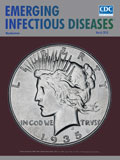
Volume 24, Number 3—March 2018
Research Letter
Mycobacterium avium subsp. hominissuis Infection in a Domestic Rabbit, Germany
On This Page
Abstract
Mycobacterium avium subsp. hominissuis is an opportunistic pathogen present in soil and dust. We report M. avium subsp. hominissuis infection found in a domestic rabbit in Hannover, Germany, in May 2017.

Figure. Results of histologic testing of samples from a domestic rabbit with Mycobacterium avium subsp. hominissuis infection, Germany. A) Hematoxylin and eosin stain reveals multifocal severe granulomatous enteritis in the ileum with...
Mycobacterium avium subsp. hominissuis is an opportunistic pathogen with zoonotic potential (1,2) that is present in soil and dust. Animals are seen as a reservoir and potential threat for human infection, but the route and source of human infection remains unknown in most cases (3–6). We report on a 4-year-old intact male rabbit from a private breeder in Germany that died suddenly in May 2017. Several months before death, the rabbit showed intermittent diarrhea, and the veterinarian suspected coccidiosis. Necropsy findings included cachexia with small amounts of a clear fluid in body cavities due to hypoproteinemia; dehydration; multifocal intramural nodules <4 mm in diameter in the jejunum and ileum; highly liquefied intestinal contents without molding; and enlarged mesenteric lymph nodes. We detected single coccidia parasites in a native intestinal smear. Histologically, the nodular lesions in the ileum showed severe granulomatous enteritis with large areas of necrosis and numerous multinucleated giant cells (Figure, panel A). Ziehl-Neelsen stain demonstrated large numbers of acid-fast bacilli in macrophages and multinucleated giant cells in the intestine (Figure, panel B). The mesenteric lymph node also exhibited a granulomatous inflammation with multinucleated giant cells. Additionally, the rabbit had mild suppurative splenitis, mild lymphohistiocytic to granulomatous hepatitis, mild focal lymphocytic interstitial orchitis, and a hyperplasia of the myeloic cell line in the femoral and sternal bone marrow. We detected no acid-fast bacilli in the mesenteric lymph nodes, the spleen, or the liver.
We decontaminated sections of the small intestine using NALC-NaOH and cultivated on Löwenstein-Jensen (Artelt-Enclit GmbH, Germany), Stonebrink (Artelt-Enclit), and Herrold’s Egg Yolk (Becton Dickinson GmbH, Germany) agar slants (the last supplemented with Mycobactin J), as well as in Kirchner medium (Artelt-Enclit). We extracted DNA from grown colonies after heat inactivation by ultrasonic cell lysis and analyzed the DNA by PCRs targeting insertion sequence (IS) 1245, IS900, and IS901. The presence of IS1245-specific and absence of IS900- and IS901-specific PCR products identified the bacilli as Mycobacterium avium subsp. hominissuis. Additionally, DNA sequencing of a rpoB gene PCR fragment yielded 100% sequence identity to rpoBfrom M. avium ssp. hominissuis strain IWGMT49 (GenBank accession no. EF521911) (7).
M. avium subsp. hominissuis is not currently a reported pathogen for rabbits. It has been reported only once in a slaughtered rabbit, but that animal showed no clinical or pathological abnormalities (8). In our investigation, as in reports in other host species, the source and route of infection was unclear. The presence of enteric inflammatory lesions with presence of acid-fast bacilli, however, suggests an oral route of infection.
It has been reported that a mycobacterial infection is dependent on the immunity and nutritional status of the host (2,9). In this case, the infestation with coccidia, common intestinal parasites in rabbits that can cause emaciation, may have contributed to the massive mycobacterial infection. Nevertheless, clinically manifest mycobacterial infection is a rare finding in domestic rabbits. We encourage awareness of a potential zoonosis, such as infection with M. avium subsp. hominissuis, in rabbits with intermittent diarrhea and chronic weight loss.
Ms. Klotz is a veterinarian and postgraduate doctoral student in the Department of Pathology, University of Veterinary Medicine, Hanover, since 2014. Additionally, she participates in the training for the certifying examination of the European College of Veterinary Pathologists.
Acknowledgment
We thank Caroline Schütz, Claudia Herrmann, Christiane Namneck, and Uta Brommer for their excellent technical assistance.
References
- Slany M, Ulmann V, Slana I. Avian mycobacteriosis: still existing threat to humans. BioMed Res Int. 2016;2016:4387461.
- Tortoli E. Clinical manifestations of nontuberculous mycobacteria infections. Clin Microbiol Infect. 2009;15:906–10.
- Lahiri A, Kneisel J, Kloster I, Kamal E, Lewin A. Abundance of Mycobacterium avium ssp. hominissuis in soil and dust in Germany—implications for the infection route. Lett Appl Microbiol. 2014;59:65–70.
- Haist V, Seehusen F, Moser I, Hotzel H, Deschl U, Baumgärtner W, et al. Mycobacterium avium subsp. hominissuis infection in 2 pet dogs, Germany. Emerg Infect Dis. 2008;14:988–90.
- Kriz P, Jahn P, Bezdekova B, Blahutkova M, Mrlik V, Slana I, et al. Mycobacterium avium subsp. hominissuis infection in horses. Emerg Infect Dis. 2010;16:1328–9.
- Shitaye EJ, Grymova V, Grym M, Halouzka R, Horvathova A, Moravkova M, et al. Mycobacterium avium subsp. hominissuis infection in a pet parrot. Emerg Infect Dis. 2009;15:617–9.
- Ben Salah I, Adékambi T, Raoult D, Drancourt M. rpoB sequence-based identification of Mycobacterium avium complex species. Microbiology. 2008;154:3715–23.
- Arrazuria R, Sevilla IA, Molina E, Pérez V, Garrido JM, Juste RA, et al. Detection of Mycobacterium avium subspecies in the gut-associated lymphoid tissue of slaughtered rabbits. BMC Vet Res. 2015;11:130.
- Gupta KB, Gupta R, Atreja A, Verma M, Vishvkarma S. Tuberculosis and nutrition. Lung India. 2009;26:9–16.





















.jpg)












No hay comentarios:
Publicar un comentario